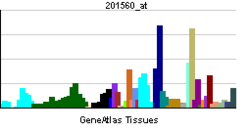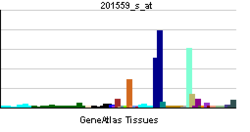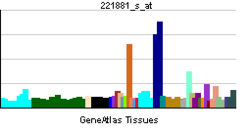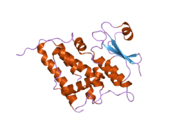- CLIC4
-
Chloride intracellular channel 4, also known as CLIC4, is a eukaryotic gene.[1]
Chloride channels are a diverse group of proteins that regulate fundamental cellular processes including stabilization of cell membrane potential, transepithelial transport, maintenance of intracellular pH, and regulation of cell volume. Chloride intracellular channel 4 (CLIC4) protein, encoded by the CLIC4 gene, is a member of the p64 family; the gene is expressed in many tissues and exhibits an intracellular vesicular pattern in Panc-1 cells (pancreatic cancer cells).[1]
Contents
Binding partners
CLIC4 binds to dynamin I, α-tubulin, β-actin, creatine kinase and two 14-3-3 isoforms.[2]
See also
References
- ^ a b "Entrez Gene: CLIC4 chloride intracellular channel 4". http://www.ncbi.nlm.nih.gov/sites/entrez?Db=gene&Cmd=ShowDetailView&TermToSearch=25932.
- ^ Suginta W, Karoulias N, Aitken A, Ashley RH. (October 2001). "Chloride intracellular channel protein CLIC4 (p64H1) binds directly to brain dynamin I in a complex containing actin, tubulin and 14-3-3 isoforms". Biochem. J. 359 (Pt1): 55–64. doi:10.1042/0264-6021:3590055. PMC 1222121. PMID 11563969. http://www.pubmedcentral.nih.gov/articlerender.fcgi?tool=pmcentrez&artid=1222121.
Further reading
- Berryman M, Bretscher A (2000). "Identification of a Novel Member of the Chloride Intracellular Channel Gene Family (CLIC5) That Associates with the Actin Cytoskeleton of Placental Microvilli". Mol. Biol. Cell 11 (5): 1509–21. PMC 14863. PMID 10793131. http://www.pubmedcentral.nih.gov/articlerender.fcgi?tool=pmcentrez&artid=14863.
- Berryman MA, Goldenring JR (2004). "CLIC4 is enriched at cell-cell junctions and colocalizes with AKAP350 at the centrosome and midbody of cultured mammalian cells". Cell Motil. Cytoskeleton 56 (3): 159–72. doi:10.1002/cm.10141. PMID 14569596.
- Bohman S, Matsumoto T, Suh K, et al. (2006). "Proteomic analysis of vascular endothelial growth factor-induced endothelial cell differentiation reveals a role for chloride intracellular channel 4 (CLIC4) in tubular morphogenesis". J. Biol. Chem. 280 (51): 42397–404. doi:10.1074/jbc.+M506724200. PMID 16239224.
- Chuang JZ, Milner TA, Zhu M, Sung CH (1999). "A 29 kDa intracellular chloride channel p64H1 is associated with large dense-core vesicles in rat hippocampal neurons". J. Neurosci. 19 (8): 2919–28. PMID 10191309.
- Duncan RR, Westwood PK, Boyd A, Ashley RH (1997). "Rat brain p64H1, expression of a new member of the p64 chloride channel protein family in endoplasmic reticulum". J. Biol. Chem. 272 (38): 23880–6. doi:10.1074/jbc.272.38.23880. PMID 9295337.
- Edwards JC (1999). "A novel p64-related Cl- channel: subcellular distribution and nephron segment-specific expression". Am. J. Physiol. 276 (3 Pt 2): F398–408. PMID 10070163.
- Qian Z, Okuhara D, Abe MK, Rosner MR (1999). "Molecular cloning and characterization of a mitogen-activated protein kinase-associated intracellular chloride channel". J. Biol. Chem. 274 (3): 1621–7. doi:10.1074/jbc.274.3.1621. PMID 9880541.
- Gerhard DS, Wagner L, Feingold EA, et al. (2004). "The Status, Quality, and Expansion of the NIH Full-Length cDNA Project: The Mammalian Gene Collection (MGC)". Genome Res. 14 (10B): 2121–7. doi:10.1101/gr.2596504. PMC 528928. PMID 15489334. http://www.pubmedcentral.nih.gov/articlerender.fcgi?tool=pmcentrez&artid=528928.
- Hartley JL, Temple GF, Brasch MA (2001). "DNA Cloning Using In Vitro Site-Specific Recombination". Genome Res. 10 (11): 1788–95. doi:10.1101/gr.143000. PMC 310948. PMID 11076863. http://www.pubmedcentral.nih.gov/articlerender.fcgi?tool=pmcentrez&artid=310948.
- Ota T, Suzuki Y, Nishikawa T, et al. (2004). "Complete sequencing and characterization of 21,243 full-length human cDNAs". Nat. Genet. 36 (1): 40–5. doi:10.1038/ng1285. PMID 14702039.
- Rønnov-Jessen L, Villadsen R, Edwards JC, Petersen OW (2002). "Differential Expression of a Chloride Intracellular Channel Gene, CLIC4, in Transforming Growth Factor-β1-Mediated Conversion of Fibroblasts to Myofibroblasts". Am. J. Pathol. 161 (2): 471–80. doi:10.1016/S0002-9440(10)64203-4. PMC 1850723. PMID 12163372. http://www.pubmedcentral.nih.gov/articlerender.fcgi?tool=pmcentrez&artid=1850723.
- Rual JF, Venkatesan K, Hao T, et al. (2005). "Towards a proteome-scale map of the human protein-protein interaction network". Nature 437 (7062): 1173–8. doi:10.1038/nature04209. PMID 16189514.
- Shiio Y, Suh KS, Lee H, et al. (2006). "Quantitative proteomic analysis of myc-induced apoptosis: a direct role for Myc induction of the mitochondrial chloride ion channel, mtCLIC/CLIC4". J. Biol. Chem. 281 (5): 2750–6. doi:10.1074/jbc.+M509349200. PMID 16316993.
- Simpson JC, Wellenreuther R, Poustka A, et al. (2001). "Systematic subcellular localization of novel proteins identified by large-scale cDNA sequencing". EMBO Rep. 1 (3): 287–92. doi:10.1093/embo-reports/kvd058. PMC 1083732. PMID 11256614. http://www.pubmedcentral.nih.gov/articlerender.fcgi?tool=pmcentrez&artid=1083732.
- Singh H, Ashley RH (2007). "CLIC4 (p64H1) and its putative transmembrane domain form poorly selective, redox-regulated ion channels". Mol. Memb. Biol. 24 (1): 41–52. doi:10.1080/09687860600927907. PMID 17453412.
- Singh H, Cousin MA, Ashley RH (2007). "Functional reconstitution of mammalian 'chloride intracellular channels' CLIC1, CLIC4 and CLIC5 reveals differential regulation by cytoskeletal actin". FEBS J. 274 (24): 6306–6316. doi:10.1111/j.1742-4658.2007.06145.x. PMID 18028448.
- Singh H (2010). "Two decades with dimorphic Chloride Intracellular Channels (CLICs)". Febs letters. 584 (10): 2112–21. doi:10.1016/j.febslet.2010.03.013. PMID 20226783.
- Strausberg RL, Feingold EA, Grouse LH, et al. (2003). "Generation and initial analysis of more than 15,000 full-length human and mouse cDNA sequences". Proc. Natl. Acad. Sci. U.S.A. 99 (26): 16899–903. doi:10.1073/pnas.242603899. PMC 139241. PMID 12477932. http://www.pubmedcentral.nih.gov/articlerender.fcgi?tool=pmcentrez&artid=139241.
- Suginta W, Karoulias N, Aitken A, Ashley RH (2003). "Chloride intracellular channel protein CLIC4 (p64H1) binds directly to brain dynamin I in a complex containing actin, tubulin and 14-3-3 isoforms". Biochem. J. 359 (Pt 1): 55–64. doi:10.1042/0264-6021:3590055. PMC 1222121. PMID 11563969. http://www.pubmedcentral.nih.gov/articlerender.fcgi?tool=pmcentrez&artid=1222121.
- Valenzuela SM, Martin DK, Por SB, et al. (1997). "Molecular cloning and expression of a chloride ion channel of cell nuclei". J. Biol. Chem. 272 (19): 12575–82. doi:10.1074/jbc.272.19.12575. PMID 9139710.
- Wick M, Bürger C, Brüsselbach S, et al. (1994). "Identification of serum-inducible genes: different patterns of gene regulation during G0-->S and G1-->S progression". J. Cell. Sci. 107 ( Pt 1): 227–39. PMID 8175911.
- Wiemann S, Arlt D, Huber W, et al. (2004). "From ORFeome to Biology: A Functional Genomics Pipeline". Genome Res. 14 (10B): 2136–44. doi:10.1101/gr.2576704. PMC 528930. PMID 15489336. http://www.pubmedcentral.nih.gov/articlerender.fcgi?tool=pmcentrez&artid=528930.
- Wiemann S, Weil B, Wellenreuther R, et al. (2001). "Toward a Catalog of Human Genes and Proteins: Sequencing and Analysis of 500 Novel Complete Protein Coding Human cDNAs". Genome Res. 11 (3): 422–35. doi:10.1101/gr.GR1547R. PMC 311072. PMID 11230166. http://www.pubmedcentral.nih.gov/articlerender.fcgi?tool=pmcentrez&artid=311072.
External links
This article incorporates text from the United States National Library of Medicine, which is in the public domain.
PDB gallery Ca2+: Calcium channel Ligand-gatedNa+: Sodium channel Constitutively activeProton gatedK+: Potassium channel Kvα1-6 (1.1, 1.2, 1.3, 1.4, 1.5, 1.6, 1.7, 1.8) · (2.1, 2.2) · (3.1, 3.2, 3.3, 3.4) · (4.1, 4.2, 4.3) · (5.1) · (6.1, 6.2, 6.3, 6.4)
Kvα7-12 (7.1, 7.2, 7.3, 7.4, 7.5) · (8.1, 8.2) · (9.1, 9.2, 9.3) · (10.1, 10.2) · (11.1/hERG, 11.2, 11.3) · (12.1, 12.2, 12.3)
Kvβ (1, 2, 3) · KCNIP (1, 2, 3, 4) · minK/ISK · minK/ISK-like · MiRP (1, 2, 3) · Shaker geneOther Cl-: Chloride channelHVCN1GeneralCategories:- Human proteins
- Chromosome 1 gene stubs
- Ion channels
Wikimedia Foundation. 2010.






